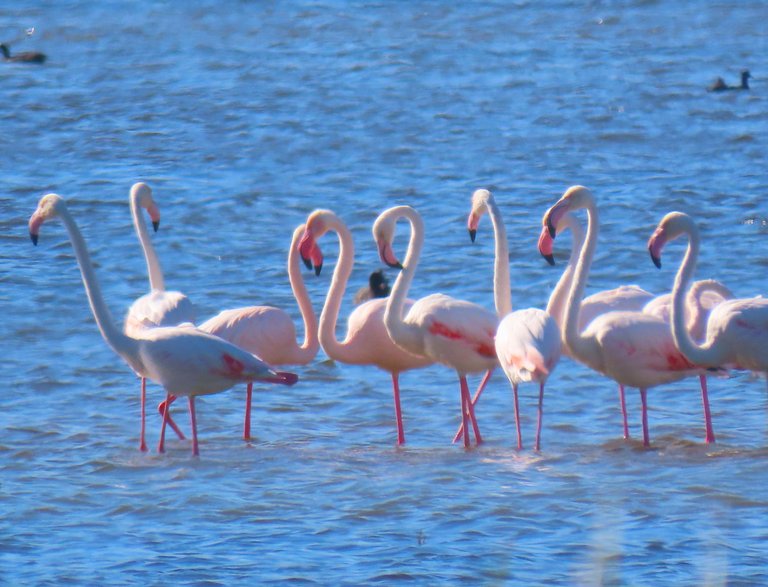The flamingos have arrived.
They were far off as the growth has started to overtake the lake again.

The greater flamingo (Phoenicopterus roseus) is the most widespread and largest species of the flamingo family. Common in the Old World, they are found in Northern (coastal) and Sub-Saharan Africa, the Indian Subcontinent (south of the Himalayas), the Middle East, the Levant, the Persian Gulf, the Gulf of Aden, the Red Sea, and the Mediterranean countries of Southern Europe.
The greater flamingo resides in mudflats and shallow coastal lagoons with salt water. Using its feet, the bird stirs up the mud, then sucks water through its bill and filters out small shrimp, brine shrimp, other crustaceans, seeds (such as rice), blue-green algae, microscopic organisms (such as diatoms), insect larvae (such as chironomids), and mollusks. The greater flamingo feeds with its head down, its upper jaw movable and not rigidly fixed to its skull.
Look how bright the sunshine was, as this heron crossed overhead. During summer last year I walked to the center of the lake, as it was all dried up.
This was all water a few weeks ago, but now the grasses have covered it.
Okay, now let's have a look at the flamingos in the photos below.
We love to see how they turn their necks to sleep, but the one at the right almost lost its balance.
Further back on the lake was another string of sleeping flamingos.
So, these at the front started waking up, as you will see below.
Some ducks were also starting to move to another spot on the lake.
It is a real wonder to see the birds in the wild, untouched by human hands, and just to stand and watch their beauty. Slow gracious movements as if they have all of the time in the world to do their thing. It makes me think of the human race, and our impatient rushing around to get things done. Twice now we were almost forced off the road in our car by drivers that overtake us in the face of oncoming cars. Yesterday was the latest incident, and the funny thing is that we stopped right next to culprit at the red traffic light. So, I gave the driver a piece of my mind and the excuse was that he is in a hurry. Maybe he must be chained in a chair and forced to watch the slow style of the flamingos for a few days, or weeks.
Such is life.
I hope you enjoyed the pictures and the story.
Photos by Zac Smith-All Rights Reserved.
Camera: Canon PowershotSX70HS Bridge camera.
Thank you kindly for supporting this post.









impressive
Thanks!
This is truly an amazing bird appearance, its neck is very cute.
Amazing indeed, and it needs that long neck in order to scoop up its food in the water. !LOL
lolztoken.com
The corner—they’re usually 90 degrees.
Credit: reddit
@reachdreams, I sent you an $LOLZ on behalf of papilloncharity
(2/10)
We have a flamingo in the summer. It is the most beautiful coral shade, very bright. Originally there were a pair, but only one arrives now to live in an artificial pond. The owners have put a flamingo statue and a mirror where it lands so it sees a its reflection. Everyone hopes it feels less lonely. This time of year it will be somewhere warmer.
I have seen those flamingos in a bird park here, but they don't come to our country. They are indeed very beautiful. The owners should have rather set the one free, unless it is free already and it just comes in to land. We also hope that it will feel less lonely.
!PIZZA and !LUV
@shanibeer, @papilloncharity(3/10) sent you LUV. | tools | discord | community | HiveWiki | <>< daily
What a beautiful photography my brother
Thank you for the compliment. !LOL
lolztoken.com
Because he thought there would be shots.
Credit: reddit
@riyat, I sent you an $LOLZ on behalf of papilloncharity
(4/10)
Farm LOLZ tokens when you Delegate Hive or Hive Tokens.
Click to delegate: 10 - 20 - 50 - 100 HP
$PIZZA slices delivered:
@papilloncharity(2/15) tipped @muhammadhalim
papilloncharity tipped shanibeer
papilloncharity tipped selflessgem
It's lovely to look at the flamingos lining up in the lake.
Thank you, and lovely indeed.
!PIZZA and !LUV
@selflessgem, @papilloncharity(1/10) sent you LUV. | tools | discord | community | HiveWiki | <>< daily
Flamingos are always very elegant and their color is beautiful, in Cuba their population is in very specific areas and it is difficult to see them in the wild. I liked your photos. Greetings
Such a pity that you cannot see them in the wild, as the freedom makes them more beautiful.
Thank you and greetings also to you.
!PIZZA
If in freedom they are more beautiful, greetings.
Agreed. !LOL
lolztoken.com
There was nothing left but de Brie.
Credit: reddit
@muhammadhalim, I sent you an $LOLZ on behalf of papilloncharity
(1/10)
Delegate Hive Tokens to Farm $LOLZ and earn 110% Rewards. Learn more.
lolztoken.com
Thank you for being an !LOLZ supporter.